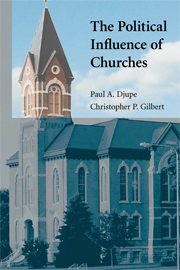Book contents
- Frontmatter
- Contents
- Acknowledgments
- Introduction: A Theory of Religious Influence on Political Behavior
- 1 Social Networks and Church Structure
- 2 Clergy Influences and Religious Commitment Reconsidered
- 3 Church-Centered Influences on Public Opinion
- 4 The Resourceful Believer
- 5 The Construction of Political Mobilization in Churches
- 6 Present but Not Accounted for?
- 7 Conclusion
- Appendix: Variable Coding
- References
- Index
6 - Present but Not Accounted for?
Churches, Institutional Treatment, and Gender Differences in Civic Resources
Published online by Cambridge University Press: 05 June 2012
- Frontmatter
- Contents
- Acknowledgments
- Introduction: A Theory of Religious Influence on Political Behavior
- 1 Social Networks and Church Structure
- 2 Clergy Influences and Religious Commitment Reconsidered
- 3 Church-Centered Influences on Public Opinion
- 4 The Resourceful Believer
- 5 The Construction of Political Mobilization in Churches
- 6 Present but Not Accounted for?
- 7 Conclusion
- Appendix: Variable Coding
- References
- Index
Summary
in this chapter we investigate the sources of an important form of social inequality: the social processes by which men and women acquire participatory resources in civic organizations. A generation of research has led scholars to consider the links between a variety of civic activities – many of which are inclusive of women – and political participation. Civic skills and recruitment are fundamental forces promoting political activity in the United States; moreover, considerable research demonstrates that American churches are an important supplier of civic skills, partially subsidizing resource deficits among their members (Verba, Schlozman, and Brady 1995; Wald 1997). However, we will argue that alternative paths to the public square, such as churches, offer no simple solutions for achieving political equality. Thus, we add to the political participation literature by specifying the extent to which men and women acquire civic skills and are targets for political recruitment within churches.
In the United States, women are paid less than men (Strasburg 2005); women are more likely to belong to sex-segregated voluntary associations (McPherson and Smith-Lovin 1986); women participate more in churches (Fowler et al. 2004: 270); and women are less likely to be chosen by men to discuss politics (Huckfeldt and Sprague 1995). While some scholars have suggested that these patterns result from discriminatory barriers and resource imbalances (e.g., Burns, Schlozman, and Verba 2001), others have advanced the notion that women respond to different cues than men.
- Type
- Chapter
- Information
- The Political Influence of Churches , pp. 211 - 239Publisher: Cambridge University PressPrint publication year: 2008

